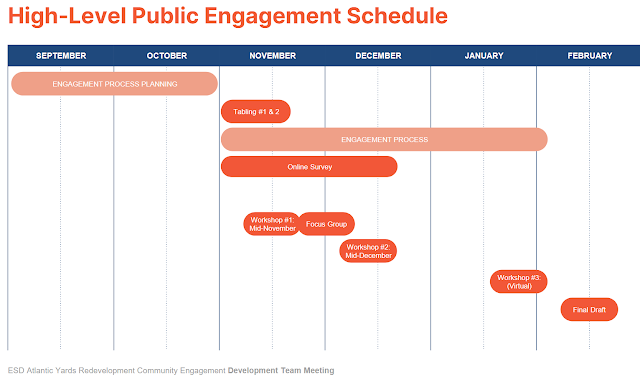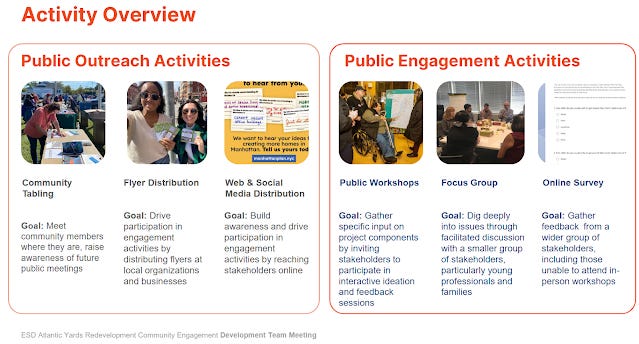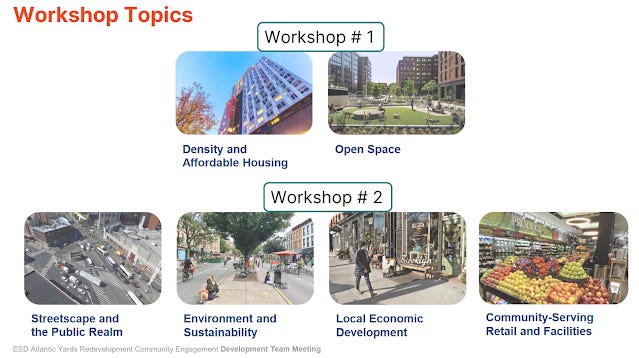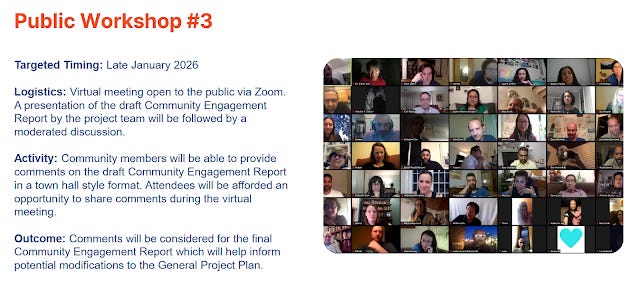As Project Reboots, a Tight--but Augmented--Schedule for Community Engagement, Starting Next Month
Advisory group thought two in-person sessions, then an online wrap-up, couldn't address issues like housing, density, transportation, public space and more. Now there will be a fourth workshop.
My City Limits article on future of Atlantic Yards/Pacific Park, based on the Oct. 9 meeting of the Atlantic Yards Community Development Corporation (AY CDC) only briefly addressed upcoming plans for community engagement, which is supposed to shape—or maybe validate—the project.
The AY CDC is supposed to oversee project commitments and advise parent Empire State Development (ESD), the state authority that oversees/shepherds the project.
As I wrote, in New Development Team Promises Atlantic Yards Progress, But Housing Penalties Called ‘Insufficient’:
ESD has hired the firm Karp Strategies for a community engagement process, starting in mid-November, seeking feedback on issues of density, affordable housing, open space, the streetscape, and economic development.
It will start “with a presentation of where we stand, what has been built today,” said Pycior, “then explaining what the development team is proposing, not as a done deal, but as a thing to respond to.”
Two in-person meetings, as well as an online survey and other feedback, would culminate in a January Zoom meeting to take public comment on a draft public engagement report. Some AYCDC directors, however, suggested a third meeting before the Zoom; ESD officials said they’d consider that.
Well, that discussion deserves more depth. Also, it’s already slightly out of date, given that a fourth session has been scheduled.
New design, new scale?
Look at Pycior’s statement: “explaining what the development team is proposing, not as a done deal, but as a thing to respond to.”
That implies that the new joint venture involving Cirrus Workforce Housing and LCOR already has a proposal—surely an expansion offering more valuable square footage—in mind, even if they were not, at an initial meeting, willing to reveal it.
Might that proposal emerge in a leak to a reasonably friendly publication? Once the New York Times was the developer’s outlet of choice, then the New York Daily News, then the New York Post.
It’s hard to think that public opinion--which may or may not be representative, given active organization by some groups and “engagement fatigue” among others--could significantly shape the plan, especially since governmental assistance and concessions, on funding and density, may be crucial.
The discussion
Pycior told AY CDC directors (see video here) that they had “submitted really thoughtful comments” on the community engagement plan, and also had gotten feedback from local elected officials--and could rely on lessons learned from past engagement processes.
The envisioned engagement schedule, she said, “tries to strike that balance between some substantive community input and then progress that can get us to an MOU,” or memorandum of understanding, by the end of March or, with a contingency. to the end of July. (Given the project’s history, the end of July is a better bet.)

Note: this would not be the only public engagement, because a new Modified General Project Plan would go through a required environmental review, with public hearings and public comments. But these meetings would essentially help pre-ratify the next plan.
The process would begin with community tabling, and flyer distribution, “though we would love some suggestions,” Pycior said, “to maximize reaching populations that may not otherwise get engaged. Also an online survey and focus groups could offer guidance.
Public workshops
“There are so many things related to this project that people are passionate about,” Pycior said. The first in-person workshop, in mid-November (and after the mayoral election), would address both open space and the combination of density and affordable housing.
The latter implies that only larger buildings--or, perhaps lucrative condos--could generate affordability, though that also depends on public resources for direct subsidies and low-cost financing.
A second workshop, in mid-December, would address multiple issues: streetscape and the public realm; environment and sustainability; local economic development; and community-serving retail and facilities.
At the workshop, smaller groups could address each issue, and stations could afford people an opportunity to be heard by facilitators taking notes.
Final workshop?
In a final workshop, scheduled for late January, a draft community engagement report would be presented in a Zoom meeting, with public comments solicited, the directors were told. That would lead to a final report.
Not enough?
AY CDC Directors wondered if the plan was sufficient to reach everyone interested. Tamara McCaw asked if there would be multiple workshops in each category. She was told no.
What, she asked, might the event capacity be? “We were thinking a large school gym,” Pycior said. Some suggested the new hybrid intermediate/high school at Sixth Avenue between Pacific and Dean streets, known as the Pacific Park Campus..
McCaw suggested more space for engagement. Similarly, Director Shawn Austin noted that “those are four meaty topics” and wondered whether the second session would need four hours, or even eight hours.
Later, during the public comment period, Julian Morales, organizing and advocacy manager with the non-profit housing group Fifth Avenue Committee (whose executive director, Michelle de la Uz, had criticized the limited penalties for missing affordable housing), observed that the topic of affordable housing and density might itself merit three workshops.
“I would encourage trying to identify finding more ways to have those conversations,” Morales said.
Broadening the focus
“I share the concern about piling” all the topics into the second workshop, added Director Gib Veconi. He suggested that the topic of transportation be added. Pycior said that would be covered under streetscape.
Veconi also recommended broadening the scope of open space to include public space, including deal not just the open space created around the buildings, dubbed “Pacific Park,” but also “the indoor public space that was supposed to be part of the original plan,” the Urban Room atrium attached to the unbuilt B1 tower, once slated to loom over the arena.
As a leader of the BrooklynSpeaks coalition, Veconi in 2022 spearheaded a protest of the state’s failure to enforce penalties for the missing Urban Room—a precursor of the state’s unwillingness to fully enforce penalties for the unbuilt affordable housing.
“I just I want to flag that the project has a commitment to create indoor public space as well,” he said. BrooklynSpeaks has proposed indoor public space on Site 5, the parcel catercorner to the arena long home to the big-box stores P.C. Richard and the now-closed Modell’s (which is now the Brooklyn Basketball Training Center).
That parcel is slated for a giant, two-tower project, as my article explained.
Now, another workshop
AY CDC Chair Daniel Kummer suggested that another workshop might be held in January. He asked if a third workshop, prior to the then-planned final one, could be considered.
Pycior said ESD would have a response in a week. Yesterday, ESD told me that, indeed, they are planning another workshop, making a total of four. (The topic and mode wasn’t specified.)
At the meeting, Director Ron Shiffman suggested that a workshop address “building strong communities and what goes into that: schools, daycare centers… places for people to interact.”
Shiffman then asked if the developers would play a role in the workshops. He was told they would. (He didn’t get an answer to his first question.)
He also reflected on the Listening to the City process to address the future of the World Trade Center site, in which 5,000 people gathered at the Javits Convention Center, and had their sentiments considered, and suggested a similar tactic might be used. That didn’t get any pickup.
What about accountability?
A missing topic, said Veconi, was accountability.
(After all, the AY CDC itself was supposed to foster accountability, but it hasn’t. Moreover, the meeting itself, scheduled with just three days notice, wasn’t designed to encourage public attendance or public comment.)
“We had it [accountability] on as a bucket, but it honestly is a through-running theme,” said Pycior.
“If there’s an absence of that in this presentation in front of the public at this point, it’s going to be very difficult to move forward in the discussion,” Veconi said. “People really have to understand there’s a basis for believing something different is going to happen.”
He helped negotiated the 2014 settlement that led to the new 2025 affordable housing deadline, which was not met, and instead negotiated away into a payment de la Uz called “insufficient.”
“I think in 2014, there was a feeling that the agreement [had] a solution for accountability and performance that was going to work, but it didn’t work,” Veconi said. “So what is going to be done in the future that will overcome the shortcomings that caused the last one to fail?”
He didn’t get an answer, though the question had been addressed, more or less, earlier in the meeting with ESD assurances they’d “be coming to you with the plan and its viability, and we’ll explain how it’s being financed.”
Is that enough? BrooklynSpeaks has previously argued that proposed changes merit a third-party analysis of their financial feasibility. After all, as I’ve written, even seemingly expert analyses of the project’s finances, such as reports commissioned by ESD from the consultant KPMG, have been deeply flawed.
Public criticism
“I just want to emphasize what what Gib said about accountability,” commented Robert Puca, a Prospect Heights resident who lives across the street from the first railyard block.
“The answers we get are not satisfactory and we are the people that are living in the neighborhood that are dealing with the every single day consequences of construction,” he said, referencing periods, for example, when lights at the railyard were on all night. “A lot of the community has a sense of distrust and has a sense of even betrayal.”
“I haven’t heard one reason one legitimate reason why liquidated damages are not being collected right now,” he said. “I understand we’ve got to give new developers a chance, but I haven’t heard that.”
Earlier, he had admonished participants for using the project’s newer name. “It’s not Pacific Park. There is no park. [There are 2.7 acres of open space, but the full 8 acres won’t arrive until the project’s finished.] It’s Atlantic Yards.”
Indeed, that’s the name many old-timers use, and is attached to the project’s official documents. Let’s see if the new developers change the name. (I’ve predicted that’s likely, and even suggested “Brooklyn Central.”)




